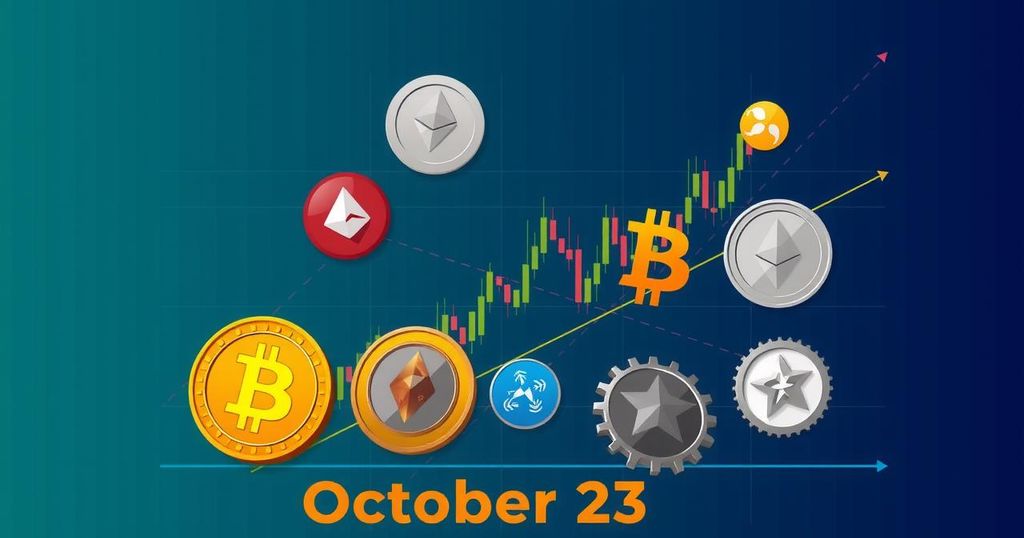Cryptocurrency Price Analysis: Trends and Insights as of October 23
As of October 23, Bitcoin is facing resistance at approximately $66,399, following a pullback to near $66,000, prompting significant selling activities leading to net outflows from ETFs. Analysts express optimism about Bitcoin’s potential post-presidential election rally, while altcoins display varying strength at crucial price levels. Market dynamics illustrate the importance of monitoring support and resistance levels across major cryptocurrencies, suggesting a cautious but anticipatory approach for traders.
As of October 23, Bitcoin (BTC) is experiencing a recovery attempt that led to resistance at approximately $66,399 on October 22, followed by selling pressures that nudged its value closer to $66,000. This retraction resulted in net outflows amounting to $79.1 million from U.S.-based Bitcoin exchange-traded funds, marking the first negative inflow since October 10, according to Farside Investors data. Despite the short-term corrections, market analysts maintain optimism regarding a potential Bitcoin rally post-U.S. Presidential elections. Notably, David Lawant, FalconX’s head of research, indicated to Bloomberg that Bitcoin’s performance would likely remain positive irrespective of the election outcomes. Veteran investor Paul Tudor Jones echoed similar sentiments on CNBC, implying that his investment strategy includes a diversified portfolio comprising gold, Bitcoin, commodities, and Nasdaq technology stocks, as he believes inflation dictates future market trends. Analysing Bitcoin’s near-term price dynamics reveals that it has returned to the significant 20-day exponential moving average (EMA) at $65,526, a critical support level. Should Bitcoin rebound from this EMA, it would signal strong buying interest, possibly leading to an attempt to push the price above $70,000, with the potential for a rally reaching $72,000. Conversely, a break and a close below the EMA may signal weakening momentum, pushing prices down towards the 50-day simple moving average (SMA) at $62,295. In Ether (ETH) analysis, the price re-entered a symmetrical triangle on October 22, reflecting market rejection of a breakout. On October 23, Ethereum breached the 20-day EMA at $2,568, indicating further selling pressure. Minor support is observed at the 50-day SMA ($2,487); however, failure to maintain this level could lead to a significant drop to $2,400 and potentially $2,330. If a rebound occurs from support levels, bullish attempts to reach $2,850 could renew. For Binance Coin (BNB), the price dipped below the crucial 20-day EMA of $585. Retaining its position above this average would suggest ongoing bullish defense, potentially leading to gains towards resistance at $635. If prices do fall below, the next slabs of support sit at the 50-day SMA ($565) and further down at $527. Solana (SOL) holds above a breakout level of $164, although robust buying has yet to materialize as sellers may aim to revert prices into the triangle formation, with downside potential towards the 20-day EMA ($155). A rebound could permit attempts to breach $172, leading to potential highs of $189. In XRP analysis, a breach below the uptrend line indicates bearish control, with support at $0.50 being pivotal for bulls. A deceleration below this level could present further declines to $0.46, while a restoration above the 50-day SMA at $0.55 could prompt a rally towards $0.64. Dogecoin (DOGE) is being pressured toward a breakout of its symmetrical triangle, with the bullish 20-day EMA ($0.12) suggesting buyers retain influence. As price moves present opportunities for dips, a recovery could see upsides towards $0.15, then $0.17 and subsequently to $0.19, although a reversal beneath triangle support may lower expectations towards the 50-day SMA ($0.11). Toncoin (TON) continues to show weakness lacking demand above moving averages, with immediate support at $5. A failure at this support could lead to values diminishing towards $4.72 and $4.44, while bullish action above moving averages could open the door for rallies towards $7, facing selling pressures at $6. Cardano (ADA) operates within the narrow corridor of $0.33 to $0.37, indicating contention between buying and selling pressures. A decline beneath this envelope could target critical support at $0.31, but a rally past $0.37 may project movements towards $0.40. Avalanche (AVAX), entrenched within a symmetrical triangle pattern, reflects a lack of decisive momentum. Falling below the 50-day SMA ($26.27) could lead to testing of triangle support. Decisive buying at support could precede sustained movements within the triangle, but breaches below may unveil declines towards $20 and $17. Lastly, Shiba Inu (SHIB) is witnessing challenges post its failure to initiate a rebound from the 20-day EMA ($0.000018). A closure below this average could target the 50-day SMA ($0.000016), suggesting price consolidation within the $0.000012 to $0.000020 zone. Remedial actions above the EMA must occur promptly to retain bullish perspectives, targeting $0.000020 where selling may intensify.
The cryptocurrency market is experiencing fluctuations influenced by broader financial conditions and investor sentiment. Recent analyses emphasize patterns across major cryptocurrencies, highlighting potential resistance and support levels that could dictate future price movements. Analysts are noting significant market behaviors leading to net outflows from Bitcoin-focused investment vehicles and speculations regarding the impact of upcoming political events on market performance.
In conclusion, the cryptocurrency market demonstrates volatility as significant cryptocurrencies such as Bitcoin and Ethereum are contending with selling pressures, while altcoins exhibit mixed support patterns. Market analysts remain cautiously optimistic about potential rebounds following economic political events, with critical price levels identified for investors to monitor as they navigate their trading strategies. The complexities of market dynamics and investor sentiment will play a crucial role in influencing future price trajectories across the cryptocurrency landscape.
Original Source: cointelegraph.com








Post Comment